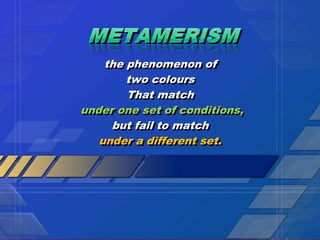3.15 metamerism
•Descargar como PPTX, PDF•
1 recomendación•2,354 vistas
Denunciar
Compartir
Denunciar
Compartir

Recomendados
Recomendados
LYCRA,SPANDEX AND OTHER ELASTANE DYEING WITH DIFFERENT COLOR COMBINATIONS AND DYES AND ITS PROCESS STUDY ACCORDING TO TEMPERATURE AND PRESSURE SUITABILITY ACCORDANCE TO DYEING PARAMETERSDYEING OF ELASTIC FIBRES ( DYEING OF SPANDEX,LYCRA,POLY-EURATHANES)

DYEING OF ELASTIC FIBRES ( DYEING OF SPANDEX,LYCRA,POLY-EURATHANES)INDIAN INSTITUTE OF TECHNOLOGY DELHI (IIT-DELHI)
Más contenido relacionado
La actualidad más candente
LYCRA,SPANDEX AND OTHER ELASTANE DYEING WITH DIFFERENT COLOR COMBINATIONS AND DYES AND ITS PROCESS STUDY ACCORDING TO TEMPERATURE AND PRESSURE SUITABILITY ACCORDANCE TO DYEING PARAMETERSDYEING OF ELASTIC FIBRES ( DYEING OF SPANDEX,LYCRA,POLY-EURATHANES)

DYEING OF ELASTIC FIBRES ( DYEING OF SPANDEX,LYCRA,POLY-EURATHANES)INDIAN INSTITUTE OF TECHNOLOGY DELHI (IIT-DELHI)
La actualidad más candente (20)
Computer color matching system in textile industry

Computer color matching system in textile industry
Nonwoven technologies: A critical analysys by Vignesh Dhanabalan

Nonwoven technologies: A critical analysys by Vignesh Dhanabalan
DYEING OF ELASTIC FIBRES ( DYEING OF SPANDEX,LYCRA,POLY-EURATHANES)

DYEING OF ELASTIC FIBRES ( DYEING OF SPANDEX,LYCRA,POLY-EURATHANES)
Destacado
Destacado (20)
Similar a 3.15 metamerism
Similar a 3.15 metamerism (16)
3.7 calculation of tristimulus values from measured reflectance values

3.7 calculation of tristimulus values from measured reflectance values
Color co ordinates and relative color strength of reactive dye influenced by ...

Color co ordinates and relative color strength of reactive dye influenced by ...
Más de QC Labs
Más de QC Labs (20)
3.14 non uniformity of cie system color differences

3.14 non uniformity of cie system color differences
1.85 combined absorption and scattering (kubelka–munk analysis)

1.85 combined absorption and scattering (kubelka–munk analysis)
Último
Último (20)
Role Of Transgenic Animal In Target Validation-1.pptx

Role Of Transgenic Animal In Target Validation-1.pptx
Z Score,T Score, Percential Rank and Box Plot Graph

Z Score,T Score, Percential Rank and Box Plot Graph
Unit-IV; Professional Sales Representative (PSR).pptx

Unit-IV; Professional Sales Representative (PSR).pptx
Basic Civil Engineering first year Notes- Chapter 4 Building.pptx

Basic Civil Engineering first year Notes- Chapter 4 Building.pptx
Energy Resources. ( B. Pharmacy, 1st Year, Sem-II) Natural Resources

Energy Resources. ( B. Pharmacy, 1st Year, Sem-II) Natural Resources
Measures of Dispersion and Variability: Range, QD, AD and SD

Measures of Dispersion and Variability: Range, QD, AD and SD
Russian Escort Service in Delhi 11k Hotel Foreigner Russian Call Girls in Delhi

Russian Escort Service in Delhi 11k Hotel Foreigner Russian Call Girls in Delhi
Ecological Succession. ( ECOSYSTEM, B. Pharmacy, 1st Year, Sem-II, Environmen...

Ecological Succession. ( ECOSYSTEM, B. Pharmacy, 1st Year, Sem-II, Environmen...
This PowerPoint helps students to consider the concept of infinity.

This PowerPoint helps students to consider the concept of infinity.
Asian American Pacific Islander Month DDSD 2024.pptx

Asian American Pacific Islander Month DDSD 2024.pptx
Measures of Central Tendency: Mean, Median and Mode

Measures of Central Tendency: Mean, Median and Mode
On National Teacher Day, meet the 2024-25 Kenan Fellows

On National Teacher Day, meet the 2024-25 Kenan Fellows
3.15 metamerism
- 1. the phenomenon of two colours That match under one set of conditions, but fail to match under a different set.
- 2. The two lights must be physically different. With coloured lights, a white light could be a mixture of approximately equal amounts of all wavelengths and could be matched by a mixture of two complementary wavelengths.
- 3. With surface colours, a sample dyed with a given set of dyes could be matched, under certain conditions, with a sample dyed with different dyes. In each case the match would be physically different, and the match would fail to hold when the conditions changed. For the white light a match for one observer would probably not be accepted as a match by a second observer.
- 4. For the dyed samples, the match would probably not hold if the light source were to be changed; the match might be satisfactory in daylight, for example, but very poor under fluorescent light. Again, a good match for one observer might be perceived as unsatisfactory by a second.
- 5. Suppose we have two objects whose tristimulus values (for a specified standard illuminant and standard observer) are identical. The two objects illuminated by the specified source and viewed by the specified standard observer would look identical, yet their reflectance curves might differ significantly.
- 6. For example, one object could have constant R values of, say, 30% at all wavelengths (and would look grey under all normal conditions), while the other object could be a piece of nylon dyed to match the first using a mixture of yellow, red and blue dyes. We can generally produce any particular grey colour using such a mixture of dyes, but it is likely that the R values will vary with wavelength. (The lowest R values would probably be found at the wavelengths of maximum absorption for each dye, say 450, 520 and 620 nm respectively.)
- 7. We can match most coloured objects (under specified conditions) using a mixture of three suitable dyes, but the reflectance curve of the dyed fabric will not be the same as that of the object to be matched. In these cases the dyeing will normally not match the target colour if the conditions are changed, and the two samples are said to be metameric, or to form a metameric pair. In terms of colour measurements, the two samples have the same tristimulus values for a specific combination of illuminant and observer, but the reflectance curves are different. Usually such pairs of reflectance curves cross at least three times.
- 8. In calculating the tristimulus values the effects of higher R values for the dyeing at some wavelengths must be balanced by the effects of lower R values at other wavelengths. If the illuminant used in the calculation is changed, not surprisingly The tristimulus values will usually change as well. This is also true if the observer is changed.
